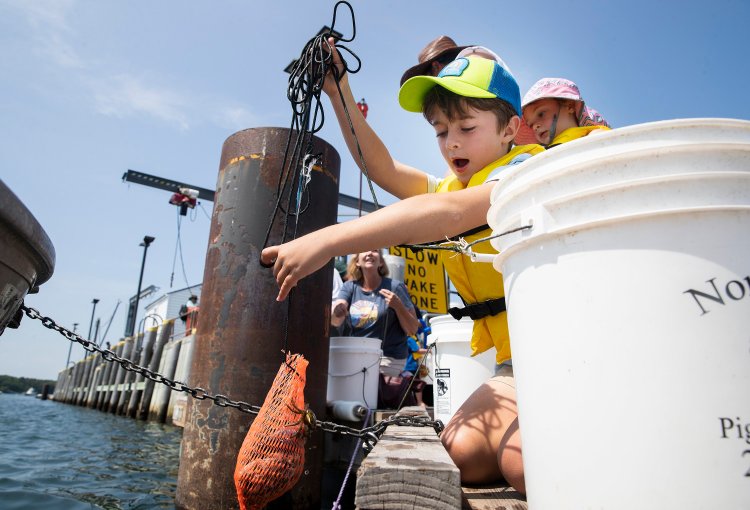
Where the Saco River drifts into the Saco Bay sits Camp Ellis, a shoreside neighborhood with a rich history as a working waterfront. As both the memory of its robust fishing culture grows more distant and the shoreline itself is threatened by erosion, a festival on the pier Sunday showed the lively persistence of the community and its commitment to preserving Camp Ellis.
“This place is about memories,” said Saco Mayor Jodi MacPhail. “People may know about it, but they have forgotten about it over the years.”
On the pier, the Camp Ellis Harborfest had 37 vendors, seven food trucks, a bike parade, games for children, science demonstrations and a crab derby competition. The event brought visitors from the neighborhood, greater Saco and beyond to enjoy the spirit of Camp Ellis in the sun and sea breeze.

The festival began organically over 30 years ago as a smaller neighborhood event. After the original annual gathering dwindled and died, the City of Saco brought it back three years ago as a larger community festival for people in the neighborhood, across Saco and beyond.
The goal of the new iteration of the festival is to spur economic growth in the area, as well as bring attention to erosion that threatens the community and people who make their livelihoods off of the piers, said Tracey Desjardins, Saco’s economic development director.
“What we want to do with the festival … is to bring awareness to the area, that it is a working waterfront,” said Desjardins.“It’s not just rentals down here, it’s a sense of something more.”
This year’s festival was in honor of the late Dean Coniaris, a deeply involved community member known informally as “the mayor of Camp Ellis,” who was dedicated to preserving the future of the neighborhood. Coniaris served as first president of Save Our Shores (SOS) Camp Ellis, now known as SOS Saco Bay, a nonprofit group that advocates for the preservation and restoration of the Saco Bay shoreline.
The advocacy group has particularly focused on Camp Ellis as its shoreline undergoes extreme erosion. The neighborhood alone has lost 39 homes and 300 feet of sandy beach to the waves, largely due to a 19th-century jetty constructed there by the Army Corps, which altered the direction of the waves. In 2023, Saco came to an agreement with the Army Corp of Engineers to construct a 750-foot stone spur jetty that would mitigate future erosion. The Army Corp also agreed to replace sand that was already lost.
While his sudden death occurred in 2018 at age 58, Dean Coniaris was honored at this year’s festival in part with the recent victory for the SOS Saco Bay and the Camp Ellis community in mind.
“He just worked endlessly on that all the time, just years and years and years with no end,” said his widow Ellen Coniaris, who was the festival’s Grand Marshall, arriving to an adoring crowd on a City of Saco Fire Department boat. “Now it’s looking like the beach is finally going to be repaired, and they wanted to thank Dean for that.”

Together Dean and Ellen Coniaris operated a small lobster boat out of Camp Ellis in addition to their other occupations. Working in eyecare during the day, both Dean Coniaris and the couple’s boat were known as the “Fish’n Optician,” a catchy title that was sported on t-shirts dotting the Harborfest crowd.
With the securing of the shoreline also comes the hope for more possibilities for Camp Ellis in a variety of ways, said the mayor.
“We’re hoping to experience more economic development,” said MacPhail, who remembers when the water in the bay could barely be seen due to the number of fishing boats docked at Camp Ellis in the 1980s.
“We’re just trying to relive that and trying to bring it back. But we can’t until the shoreline is protected,” she said.
Representing the working waterfront in a quite literal way at Harborfest was the head of an Atlantic bluefin tuna. Presented on the pier by Kaylyn Zipp and Joseph Dello Russo, PhD students at the University of Maine’s Pelagic Fisheries Lab, the two researchers demonstrated how their lab takes samples from tuna heads – often the waste of the prized catch – which inform them about the ancestry, age and size of the fish, allowing them to learn more about the tuna population and provide stock assessments.

A goal of the lab’s public education is to connect Mainers with the fish “in their own backyards,” said Zipp. Regardless of one’s own connection to fisheries, the massive fish head is difficult to ignore.
“Some people are super disgusted, some are super fascinated,” said Zipp.
“No matter what, it starts with a lot of awe,” said Dello Russo.
On the nearby dock, children got to experience the marine life of Camp Ellis’ waters up close and competitively. Through the “crab derby,” young contenders in yellow lifejackets reeled bait bags off the dock, catching ever-present green crabs below.
After each child selected a crab as their champion, it was marked with a dab of nail polish. Competing crabs were then placed in a bucket that was flipped into the center of a plywood square on the dock. The first crab to scurry off the square won the round, with winners competing for the title.
Marianne and Matt Rieiro were visiting Camp Ellis from Billerica, Mass., with their children Mia, 9, and Maddox, 7, who both competed in the crab derby after having caught crabs for the first time. After multiple rounds of races, Mia’s large crab – marked with a dab of pink nail polish that matched Mia’s outfit – was crowned the victor.
At a festival that’s heart was about looking into an uncertain future with confidence, did Mia know that her competing crustacean was going to be a winner?
“Yes,” she said simply.
Mia had won first place in the bike parade just that morning, after all.
